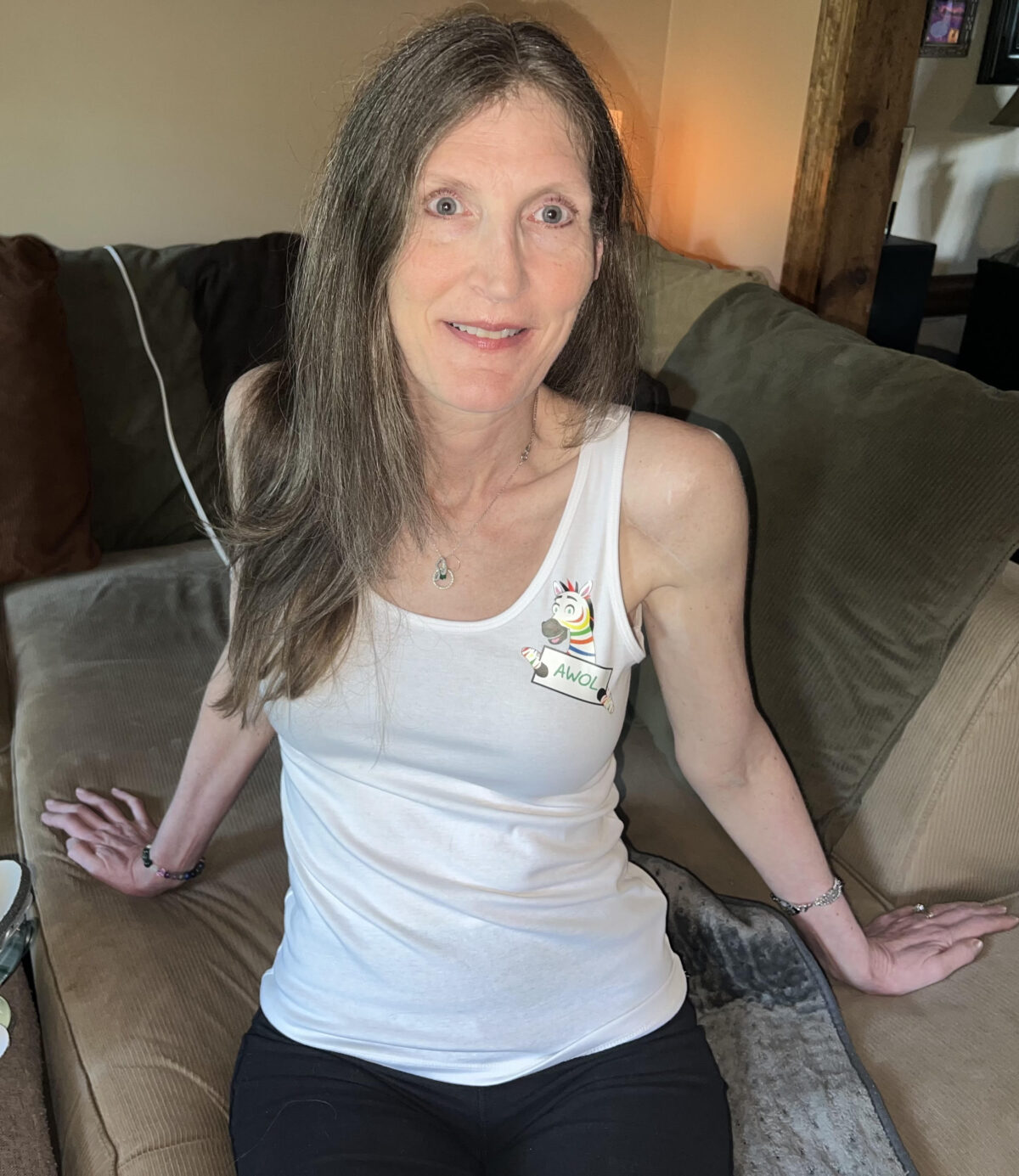My name is Christie Lynn Hanchey. Before EDS became a part of every minute of every day that I am awake, I was a disc jockey on the number one morning show in Hampton Roads, Virginia. I was born with a clubbed foot and a sunken chest, which is something that would come back to haunt me in later years. I was told at 17 I couldn’t have children with no reason given other than that I had a tilted uterus. I grew up putting my legs behind my head. I was flexible. Doctors said I was tall and lanky, and I would grow out of it. I was not coordinated. I was diagnosed with IBS, migraines, endometriosis, acid reflux, Reynaud’s, cat scratch fever (yes, it is for real), and I suffered injuries. At the age of five, I fell on my face, I broke my tailbone at seven on the water, and broke my arm at 12…but it didn’t break. It squished together like aluminum foil. I had a truck run over my foot, fell off a chair into a table, and suffered a canoe injury during college. That was all in one summer. I mention all of these injuries for a reason. We will come back to them.
In 2007, I discovered I was pregnant. My body felt the best it ever felt in my entire life. I was warm during the winter. I ate like I didn’t care if I gained weight. I gained 56 pounds and was proud of every single pound. Around the third month, I could no longer eat a lot of the foods I had eaten all my life. I have not eaten steak, chocolate, pork, pizza, and even hamburger since 2007. The only difficulty during my pregnancy was my son did not move. I would check his heartbeat every day with a monitor. I had a raccoon mask and needed an emergency scheduled C-section because I didn’t have enough amniotic fluid.
After giving birth in 2008, I felt wonderful. I went back to work and was ready for the next step in my career. In 2009 I was diagnosed with breast cancer. I was allergic to the tamoxifen. It took my ability to breathe away from me. I progressively noticed pain and tingling in my feet. I was diagnosed with idiopathic peripheral neuropathy. This took me out for weeks and then months at a time. I developed allergic reactions to aspirin, NSAIDS, and several other medications. Every year I was in the hospital for something. I could not control my body or hold my head up. I had seizures in 2016. I would get tired, and it would resemble a stroke. But there was never a diagnosis. It was always idiopathic.
In January 2021, I lost my ability to breathe and talk at the same time. By October I had lost my ability to walk. The doctors were measuring me for a wheelchair and a feeding tube. I absolutely refused the treatment for an illness that had no name. An OT came to my home to measure me. I told them no and to help me walk again. It was on that day in 2021 that I was diagnosed with hEDS and learned about fascia. Every joint in my body was subluxed and had to be put back into place. The titanium shoulder replacement I received at 43 had caused a lot of scar tissue. My quadriceps, Achilles tendon, you name it…were pulled out of place by my fascia. I had horrible muscle spasms, and you could see the dents in my back and on my body where I suffered a previous injury. That’s right. The broken tailbone was so adhered with fascia, it built up like Saran Wrap and connected to my C-section scar which connected to my diaphragm, my hips, and so on. My body was so tight and all I could feel was extreme tightness and pulling inside my body. Sometimes it would feel like rubber bands popping and breaking.
I started working on my fascia by following the pain. As I got to the deeper layers, the adhesions became visible under my skin. I also learned that my hip pain I chased for four years was adhesions pulling from my tailbone. My pain slowly eased up one release at a time. I started with the Ashley Black fascia blaster tools. My OT asked if she could use the tools on me. I now own 8 tools of my own. I did fascial remodeling every week for 2 and a half years with a fascia therapist and I work on my fascia daily in the shower.
The doctors and even some of my friends thought my fascia theories were just me hanging onto hope that I would be able to avoid the wheelchair. The doctors kept prescribing medications that caused side effects I did not want so I didn’t fill the prescriptions. I learned that my pain was coming from previous areas I had experienced trauma. The fall on my face at five caused a whiplash reaction to my body which eventually caused my shoulder to be stuck in one position. My jaw became stuck. My face hurt and I couldn’t breathe through my nostrils. I had scar tissue from the nose surgery I had in 2010 after my son accidentally broke my nose. I was in the hospital every year with something idiopathic. I changed my gait because I lost the use of my big left toe. I didn’t walk on my right foot properly. All of the overcompensating I did to avoid feeling the pain and using mobility aids was causing, unbeknownst to me, more damage.
Every injury that damaged my fascia attached to scar adhesions and my bones. I created a domino effect of ill proportions in my body. My body was stuck in constant fight or flight mode, and I couldn’t see a bright future. I was bedridden for over a year. I felt like a human Jenga. I just wanted to be pulled apart by the jaws of life. I kept describing the pain and doctors just kept medicating me. I was turning back into a pumpkin every night and I felt like my body was collapsing. I needed to get to the root cause of my pain. I could tell I wasn’t in proper posture. I couldn’t do the prescribed physical therapy and they always blamed me. My body was being pulled from the inside and I couldn’t brace my body properly. And there was no help. So, I started researching every fascia modality I could find.
I have tried almost every noninvasive modality available. I added Integrated Manual Therapy and Fascial Counterstrain. I am now working on corrective exercises.
I tried nerve stimulators and medications. Nothing worked. I discovered by releasing the fascial adhesions my pain would ease up and become more manageable. I also regained mobility, after my pelvis was put back into place and a few adhesions were released in my legs. I had severe nerve pain for three weeks. Then the pain just stopped. I relearned how to talk. I couldn’t say my son’s name. And I slowly worked on being able to walk again. I am not running marathons. But I am out of bed. And I want to pay it forward.
I suffer the majority of comorbidities that come with hEDS–POTS, MCAS, CPS, Allergies, Thyroiditis, osteoporosis, gastrointestinal issues, etc. My insurance covered the practitioners that hurt me, but it does not cover the practitioners who help. I have had to pay out of pocket and learn fascia modalities on my own to help manage my chronic pain.
5 Invisible Symptoms
- I am always feeling some pain. It feels like my diaphragm isn’t working properly and I can feel my body fighting to stay up.
- I think about this illness every minute of every day. Is my posture correct? Am I holding my breath? Heel, toe, heel, toe. Tighten your core. (all the thoughts that go through my head while trying to talk with someone or do an activity). Makes leading a normal life a little difficult. I am constantly retraining my body.
- I had extreme fatigue and depression earlier this year. I had to seek out medication for my mental wellbeing.
- Brain Fog!!!! I can no longer be the multi-tasking beast I once was. I get overwhelmed. I don’t complete the majority of things I commit to because I am stubborn. Things get done. But I am no longer the prepared one. I always feel behind.
- GUILT!!! Feeling like my son lost his childhood because I was in the bed. Because my husband works seven days a week to provide me with medical care.
4 Things That Help Me Manage Pain
- Working on my fascia.
- Doing corrective exercises.
- Following a strict Paleo elimination diet.
- Medications as needed. Ice and heat.
3 Ways My Life Has Changed
- In 2022, the doctors told me there was nothing else they could do. They told me to go to Facebook and join a support group. I despised social media. I don’t work well with technology. And no one was discussing fascia. So, I started support groups and a podcast. I want to help others that may feel lost and alone. We can manage our pain if we are shown the right modalities.
- I never experienced a subluxation knowingly until 2021. Since I started working on my fascia, I have become very aware of my body. I can find my position while doing activities now. I have not had a subluxation on my own since 2021.
- I have learned to advocate for myself and not accept the naysayers.
2 People Who Inspire Me
- Lucille Ball. She always provided a laugh. She loved her job and made it a family affair for better or worse. She knew what she wanted and went after it. She rehearsed and rehearsed so it never looked staged. She was the first female to head a studio in a male dominated field. She was able to turn her passion into a career. She advocated for herself and earned the respect of her peers.
- Dick Clark. Any disc jockey that can make a living off the radio with their voice is impressive to me. He built an empire. His voice is in almost every memory of my childhood. To leave a lasting impression with just your voice is something special that I would love to figure out. 😉
1 Thing You Want People to Know
When I was told by my doctor to get my answers through Facebook support groups, I was devastated. I didn’t do social media. Plus, no one was discussing my issues…Sticky fascia. So, I created my own groups. Then, I desperately needed to speak with others, so I started a podcast called AWOL Zebra. I went from feeling lost and alone to finding my way and advocating for myself and others. My podcast became a daily medication for me. I share all I can in hopes of helping others find a noninvasive way of treatment. Our fascia is the biggest organ in our body. Why is it just now being studied? Why does insurance not cover the modalities we need? I hope to raise awareness, so no one else has to feel alone and useless again. There is no cookie cutter approach. But this illness can be managed. AWOL Zebra has become A Way Of Life for me.
To read all of our previous zebra spotlights, please click here.


